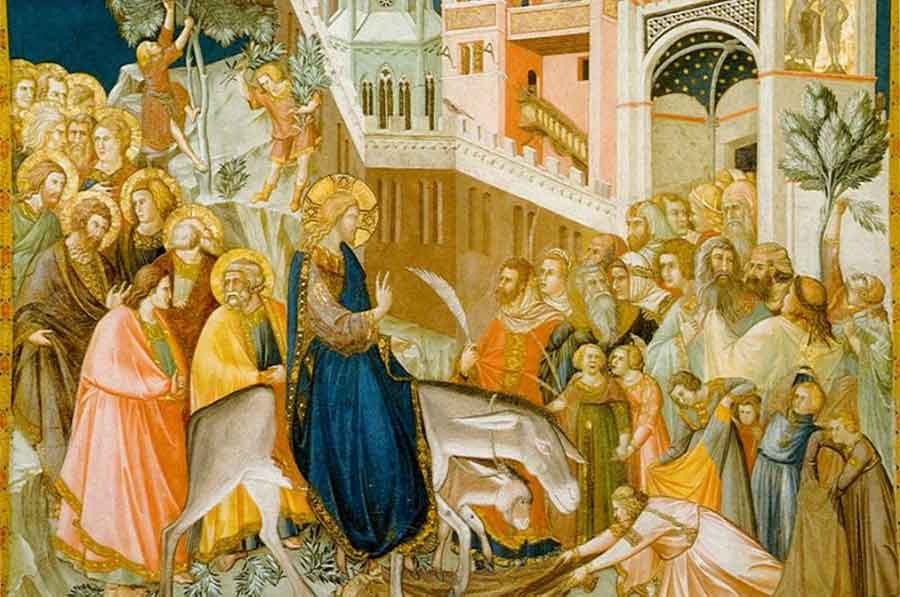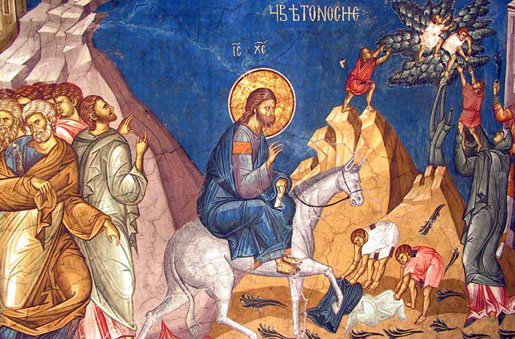The entry of Christ into Jerusalem – Palm Sunday (Greek: Η Είσοδος του Χριστού στα Ιεροσόλυμα), a moving holiday that is celebrated the day after the resurrection of Lazarus, i.e. Lazarus’ Saturday, the sixth week of Lent and the week before Easter. This holiday was established in Jerusalem at the end of the 4th century to commemorate the last, royal and solemn entry of the Lord Jesus Christ into the holy city of Jerusalem, riding on a donkey, six days before the Passover (Matt. 21: 1-10; John 12: 12-18). On that occasion, the people welcomed Him as King, spreading their garments and tree branches, carrying palm branches in their hands.
As they approached Jerusalem, they came to Bethphage and Bethany, at the Mount of Olives. Jesus sent 2 of His disciples, saying, “Go to the village ahead of you. Just as you enter it, you’ll find a colt tied there, which no one has ever ridden. Untie it and bring it here. If anyone asks you ‘why are you doing this’, tell them ‘The Lord needs it, and will send it back here shortly’.” So they went and found a colt outside in the street, tied at a doorway. As they untied it, sure enough, some people standing there asked, “What are you doing, untying that colt?” They answered as Jesus had told them to, and the people let them go. When they brought the colt to Jesus and threw their coats over it, Jesus sat on it. As Jesus rode into Jerusalem on the colt, many people spread their cloaks on the road, while others spread branches they’d cut in the fields. Those who went ahead of Jesus and who followed Him shouted,
“Hosanna! Blessed is He who comes in the Name of the Lord! Blessed is the coming Kingdom of our father David! Hosanna in the Highest!”
Some of the Pharisees in the crowd said to him, “Teacher, order your disciples to stop.” He answered, “I tell you, if these were silent, the stones would shout out.”
The word that the Savior was coming, the one who resurrected Lazarus, spread quickly and a multitude of people joined Him. Some met him with palm branches in their hands, others threw their garments on the way where he would go, others cut tree twigs and threw them on the road.
When Jesus Christ ascended the Mount of Olives, those who followed him cried out, “Hosanna to the Son of David! Blessed is he who comes in the name of the Lord, the King of Israel! ” But Jesus was sad all the way, and when he went down the mountain, he looked at Jerusalem in the valley, wept, and said, “O Jerusalem! If you only knew, especially on this day, what your happiness is; but it is now hidden from your eyes. For the days will come when your enemies will surround you on all sides, and they will break you and your children, and will not leave a stone unturned in you because you did not know the time in which you were visited. “

All this happened before the feast of the Passover, so the world from many parts had gathered in Jerusalem. When they saw Jesus entering Jerusalem, many wondered, “Who is this?” Then Christ entered the temple, where they were cursed and crippled, had mercy on them and healed them all. There was great enthusiasm among the people and the children, and they cried out to him, “Hosanna to the Son of David, King of Israel!” And when the Pharisees heard it, they said unto him, Hearest thou what these say? And he said unto them, Have ye never read, from the mouths of little children and infants, you have praised yourself. “
Throughout the day, Jesus Christ preached in the temple, and in the evening he returned to Bethany with his disciples.
The canon for this holiday was written by Kosmas Melod – a Jerusalem man (in the middle of the 8th century). This canon is considered the most beautiful canon of this great poet. The event of Christ’s entry into Jerusalem is represented on the icon as Christ riding on a donkey, followed by his disciples, while the people spread out their garments and threw twigs on the road.

